Top 3 ways to make money online|| latest ways 2020|| make money fast
Top 5 ways to make money online: very effective, latest ways 2020, cheap, 100% effective.
Do you know what is blogging? If not than you have come to a right place .In this online journal , you can share your experience with people across the globe. so, welcome to this beautiful and stupendous world of blogging.
Here we will talk about some main key points:
- what is a blog?
- Blog structure.
The appearance of blogs changed over time, and nowadays blogs include different items. But, most blogs include some standard features and structure. Here are common features that a typical blog will include:
- Header with the menu or navigation bar
- Main content area with highlighted or latest blog posts
- Sidebar with social profiles, favorite content, or call-to-action
- Footer with relevant links like a disclaimer, privacy policy, contact page, etc.
- what is the purpose of a blog?
There are many reasons to start a blog for personal use and only a handful of strong ones for business blogging. Blogging for business, projects, or anything else that might bring you money has a very straightforward purpose – to rank your website higher in Google SERPs, a.k.a. increase your visibility.
So, the main purpose of a blog is to connect you to the relevant audience. Another one is to boost your traffic and send quality leads to your website.
- what is blogging?
- why everyone wants to do blogging?
- who is a blogger?

- how much bloggers earn?
Bloggers do earn money, but this is not a get-rich-quick kind of profession.
Before you can start monetizing your blog, you need to build both your Google SERPs ranking and your niche influence. And that takes plenty of time and quality content. Money-making opportunities won’t present themselves until you’ve gained some credibility in the field. So, get down to business.
- conclusion
2)start an online store:
Do you dream of owning your own online store?
Do you have grand visions of working from your laptop while your ecommerce business rakes in sales on auto-pilot?
Whether this is your first time setting up a small business or you’ve been in the game for a while, this guide will teach you how to start an online store in 7 simple steps.
Our goal is to have your storefront up and running, including products, today. You might even make your first sale!
Here’s a quick index to help you navigate this guide:
- Step 1: Decide on your niche
- Step 2: Choose between dropshipping or holding your own products
- Step 3: Brainstorm a business name and register your domain name
- Step 4: Select products to sell
- Step 5: Create your website with an online store builder
- Step 6: Set up a company and get a sales tax ID
- Step 7: Market your new online shop
Ready to get started?
Step 1: Decide on your niche
This basically means what you're going to sell and who you're selling it to. Some first-time entrepreneurs don’t put a great deal of thought into their niche.
Your niche impacts a lot of things, including:
- Your sales figures
- How much effort you’ll have to put into customer support
Step 2: Choose between dropshipping or holding your own products.
The next step in starting up an online business? Deciding whether you want to dropship or hold your own products!
Dropshipping has become super popular, but as with anything else, it comes with its own set of challenges.
In this section, I’ll run you through the pros and cons of dropshipping versus holding your own products so you can make an informed decision on the best choice for you.
Step 3: Brainstorm a business name and register your domain name.
Your business name isn’t as make-it-or-break-it as the niche you choose, but it’s still super important.
But, if you’re not careful, it could put a halt to starting your online store!
People obsess over picking a name - I know I have. My advice is to give yourself a hard deadline of 1-2 weeks to choose the name if you’re really stuck. Otherwise you'll spend months trying to figure it out and never pull the trigger on starting.
Now, onto some do’s and don'ts to help you pick a name:
✅ DO choose a name that’s easy to pronounce.
Spelling is hard, people! So make the name SOUND like it’s spelled, and make it easy to pronounce. Otherwise people might go to the wrong URL.
✅DO choose a name with some significance.
If it’s related to the niche you’re in, it makes it easier for people to “get” your business. If there’s a deeper, more personal meaning to it, it’ll make a great backstory for media pitching.

✅ DO be as original as possible.
An entrepreneur based in Kentucky, Victor Moseley, opened a lingerie shop called “Victor’s Secret”. Victoria’s Secret promptly filed a lawsuit against them.
✅ DO choose a name with an available .com domain.
While .cos and other domain endings are becoming more popular, people will still instinctively type in .com. You want to make it as easy as possible for your customers to find you!
❌ DON’T choose a name that's too long.
Your business name should be 1-3 words, MAX! I would strongly advise sticking to one or two words. Again, the easier a name is to pronounce and type, the more people will remember it.
❌ DON’T choose a business name that’s a combination of words and numbers.
This is a no brainer, but I had to add it. That is, unless you’re trying to look dodgy and unprofessional.
❌ DON’T choose a name that references a specific product or product line.
You might be tempted to do this if you’re planning on focus your efforts on selling just one (awesome!) and highly innovative product. But what happens when you decide to branch out in the future? You’ll be stuck to that one product.
If you need some more help coming up with a name, check out Shopify’s Business Name Generator!
Step 4: Choose products to sell.
When looking for a supplier, here are a few tips to keep in mind:
- Communicate, communicate, communicate. The more you talk with them, the better you’ll get a feel. And don’t be afraid to hop on the phone.
- Avoid suppliers with excessive or weird fees.
- Make sure you ask them questions early and often. Their customer support is your customer support, especially if you’re dropshipping.
Step 5: Create your website with an online store builder
When it comes to creating an ecommerce store, there are many platforms to choose from. One of the more popular solutions for startup businesses is Shopify.
Let's walk you through how to create an online store using Shopify.
Step 5a: Sign up for a free trial
On Shopify’s main page, you’ll see an option to sign up for a free trial.
You’ll have to fill in a few details, but this will just take you two minutes.
Once you’re done, you’ll be redirected to your dashboard.
Step 5b: Choose a template/theme
Scroll down from your dashboard and click on the “Customize theme” button.
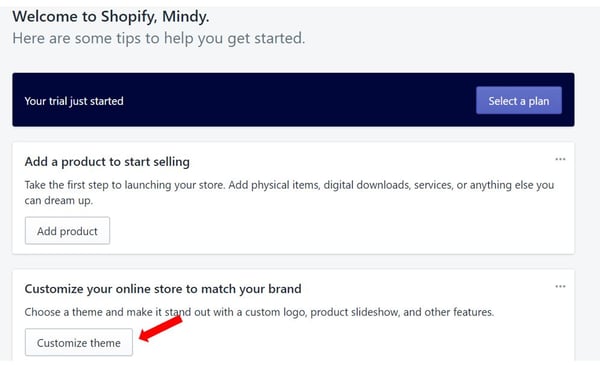
This will bring you to the “Themes” page.
Once you’re there, scroll down again, and click on “Explore free themes”.
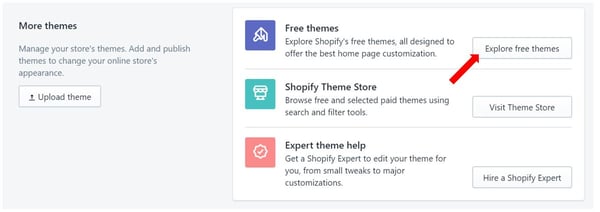
Here you’ll find about 10 free themes that you can choose from.
If you don’t like these, you can also opt to pay for a premium theme. Or, if you want something custom made, you can hire us to help you out.
Pro Tip: It’s not necessary to do this right now, but you’ll definitely want to optimize your theme for conversions further down the road. Bookmark this article and check out these great Shopify apps: Sales Motivator, Product Discount, and Customer Specific Pricing.
Once you’ve chosen a theme, it’s time to enter your products.
Step 5c: Upload your products
Shopify’s eCommerce website builder is pretty user-friendly, so this will be a breeze...
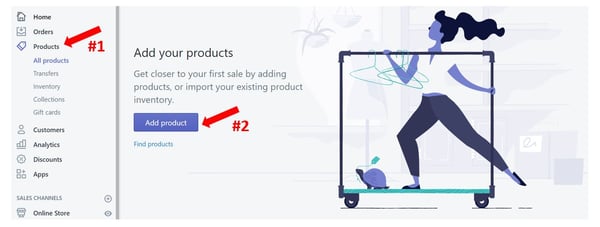
...just click on “Products” on the left-hand panel, and then click on “Add product”.
Rinse and repeat till you’ve got all your products up.
On top of filling in the standard information, such as product name, description, etc, be sure you also input your meta description for better SEO!
For more info, check out these articles:
Step 5d: Fill in your other pages
Products all done?
Great - now to fill in your other pages.
Using the same left-hand panel, click on “Online Store”, which will open up a secondary menu of options.
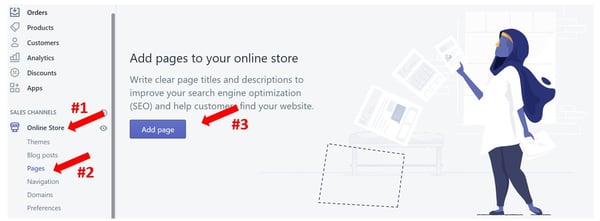
Click on “Pages”, and then “Add page”.
To start off with, you’ll want an “About Us” page, a “Shipping and Exchanges” page, and a “Contact Us” page.
Check out this guide to create a killer about us page (plus get a free template), and check out this guide to creating a return policy that actually makes you sales instead of getting returns!
Pro Tip: If you’re not much of a writer, don’t worry - you can auto-generate sample refund policies, privacy policies and even terms of service statements using Shopify. But we’re not lawyers - if you have legal questions, talk with a lawyer!
Here's how it's done:
Click on “Settings” (all the way at the bottom of that left-hand panel), and “Checkout”.
Scroll down all the way...
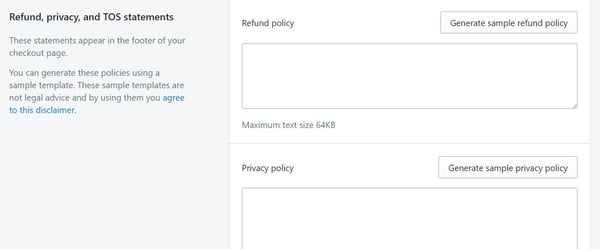
...and there you have it!
Step 5e: Look through the rest of your settings
The final step before publishing is to check over your settings and make sure everything’s accurate.
On your Checkout page (which you used to generate your policies), you can specify whether you want your customers to check out as guests or if they’ll need to create an account before checking out. (Choose the guests — make checkout as frictionless as possible.)
On your Payment Providers page, you can enable different payment methods. (PayPal and Credit Cards are a good idea! Bitcoin might not be bad either. Check out this article to learn more.)
On your Shipping page, you can set shipping rates for different zones. We have a huge guide to all things shipping you should check out for this.
On your Notifications page, you can customize the emails your customers will receive upon completing an order.
And you’re done with your website! Great job.
Step 6: Set up a company and get a sales tax ID
Once you’ve got your website, your suppliers, and your products, it’s time to think about setting up a business entity.
The main benefit to this is that your business will operate as a separate entity from you, the owner.
Essentially, this means you’re not personally liable for what happens to your business, and your personal assets are protected from any liabilities which your business might have.
You don’t necessarily need to incorporate right out of the gate.
While incorporating your business protects your personal assets, you can start as a sole proprietorship without any official paperwork. However, you’ll be taking a risk doing this.
My advice is to wait until you’re making a certain amount (say, $1,000 per month) before you incorporate. That way, the business can pay for its own incorporation and you know you’ll be doing it for the long run.
Read this article to learn more about incorporating and making sure you're doing everything legally.
Again, we’re not lawyers - if you have questions about what to do, please consult with a business lawyer! Take our advice with a grain of salt.
Now let's talk about online business sales tax.
Here’s what you need to know:
Once you create your own online store, you’ll have sales tax nexus in any state which you have physical presence (including property, employees, and inventory) in.
Let’s say you’re from Michigan, and your office (or garage), employees, and inventory are all contained within Michigan.
This means you only have nexus in one state. You only have to pay sales tax on orders placed by customers in Michigan.
Fast-forward a couple of years later, and let’s say your HQ is still in Michigan, but you now have warehouses in Texas as well.
This means you have nexuses in two states.
While you can collect sales tax in all states you have nexus in, you need to get a sales tax permit before you do that.
How do you register for a sales tax permit?
Simple - go to your state’s Department of Revenue website and register there.
Some states’ sales tax permits are free, and others will cost you a nominal sum.
Once you’ve registered for your permit, the state will give you instructions of when and how frequently your payments are due (either monthly, quarterly or annually.)
It’s a bit of a hassle to go through the paperwork, but don’t put this off! It’s illegal to collect sales tax without a permit in most states, and you don’t want to get into trouble with the law.
Step 7: Market your new online shop!
Hang in there - you’ve reached the last section of this bumper guide on how to start an online store.
You now know how to set up a company, how to set up your website, and how to meet your online business sales tax requirements.
All that’s left is to create a marketing plan for your online store, which we’ll talk about in this section.
Content marketing and SEO
You probably already know this, but Search Engine Optimization (SEO) is amazing.
You can have two online stores selling the exact same things, but you’ll see phenomenally different results if only one store is search optimized, and the other isn’t.
At the end of the day, selling stuff online is really a numbers’ game.
You’re trying to maximize the number of people who visit your online store.
And maximize your conversion rate.
And maximize your retention rate.
You get the idea. That’s where content marketing and SEO come in - high-quality content helps you rank, drives traffic to your store, and builds trust with your visitors, which increases sales.
I won’t get into the nitty gritty, but check out this guide to eCommerce content marketing.
Social media marketing
One golden rule of marketing: you want to have a presence where your consumers are hanging out.
So be sure to keep your social media pages updated and active!
I recommend setting goals for your various social media channels, because if you’re clear on what is it you want to achieve, you can reverse engineer the steps to get there.
I recommend coming up with a content calendar.
You can create and schedule your posts ahead of time and make sure you’ve always got something planned for the major holidays.
If this sounds like a lot, don’t sweat it.
Just choose ONE channel that you want to focus on first, and start small.
Also: Link your social media to your store by learning how to add your Facebook pixel to Shopify (plus 5 easy tips to maximize it).
Pay-per-click (PPC)
Most first-time entrepreneurs are hesitant to try PPC (because they’re worried they’ll end up busting their budgets).
I always get the same question:
How should I spend on PPC? Is it expensive to run these ads?
To which my reply is:
It depends - I know some ecommerce stores who spend $10k or more per month.
To someone who isn’t well-acquainted with PPC, this might sound like an insane amount of money.
But what if I told you that these companies have a 100% ROI on their PPC ads, meaning they get $20k worth of sales for every $10k they put into PPC?
That $10k ad spend doesn’t sound so ludicrous anymore, does it?
Well, here’s some good news:
According to Google’s Economic Impact Report, businesses make an average of $2 in revenue for every $1 they spend on AdWords.
So even if you’re not a wizard at PPC and your ads are mediocre, you can still make a decent profit off them.
To get started, read this guide on competitive PPC analysis.
Also, don’t forget that PPC isn’t just limited to Adwords - you have Facebook ads as well. Here’s a guide that will help you set up Facebook retargeting ads.
Email marketing
Whenever I tell online store owners the statistic I’m about to share, their jaws always drop.
You know how I just mentioned that businesses, on average, make $2 for every $1 they spend on Adwords?
Well, with every $1 businesses spend on email marketing, they make an average of $44.
Yup, you read that right. $44 for $1. Money machine!
Don’t let anyone tell you email marketing is old-school, or outdated, or boring…it’s actually insanely powerful and effective, and one of the most profitable types of marketing that exists.
Here are some resources to get you inspired:
- How to Build an Email List
- 5 types of emails your eCommerce store needs to be sending
- How to make the most of your list
Don’t wait for that “perfect” moment.
Just go ahead and start an online business today!
3) Digital marketing:
Digital marketing. Just another one of those new, fancy buzzwords you should use to sound smart in meetings or is it the real deal?
Maybe a better question is: what is digital marketing?
If you are wondering what digital marketing is… it’s is advertising delivered through digital channels. Channels such as social media, mobile applications, email, web applications, search engines, websites, or any new digital channel.
Digital marketing is any form of marketing products or services that involves electronic devices.
Digital marketing can be done both online and offline.
And, both kinds matter for a well-rounded digital marketing strategy.
The 2 main pillars of digital marketing are online marketing and offline marketing. That said, since I’ll talk about online marketing in a separate guide, I’ll only mention the different areas of online marketing here, for the sake of completeness.
The 7 big categories of online marketing are:
- Search engine optimization (SEO)
- Search engine marketing (SEM)
- Content marketing
- Social Media Marketing (SMM)
- Pay-per-click advertising (PPC)
- Affiliate marketing
- Email marketing
Here are the 4 big categories of digital offline marketing.
First, there’s what I call enhanced offline marketing. This is a form of marketing that is entirely offline, but enhanced with electronic devices.
For example, if your restaurant uses iPads for your customers to create their orders on, then the offline experience of say, eating Thai food, is enhanced with this electronic device.
People have been using digital media to enhance their marketing for decades (you’ve only forgotten in what ways, as you’ll see).
Next, there’s radio marketing. The next time you hear an annoying, over-enthusiastic car dealer shout every word of his or her commercial, thank Mr. Marconi.
Of course, we can’t forget television marketing. TV ads have been around for more than half a century (and since 1953 also in color, nationwide – Yes, there was a time before color TV).
Finally, the biggest and fastest growing area of offline marketing, with admittedly also a lot of flops, busts and failures: phone marketing.
Conclusion
That’s the scoop on digital marketing. As you can see, the internet is, by far, not the only place for marketers to gather success, even today.
Of course, no one can afford to miss out on the opportunities of the web and, eventually, every marketer will have to master online marketing.
But, employing a few of these offline marketing tactics can help you to not put all of your eggs into one basket and diversify your lead generation beyond social media, content marketing and the like.
Plus the offline and online world is colliding. Traditional devices such as fridges, ovens and even billboards will all be modernized to leverage digital media.
Here’s the breakdown of digital marketing again:
Online marketing
- Search engine optimization (SEO)
- Search engine marketing (SEM)
- Content marketing
- Social Media Marketing (SMM)
- Pay-per-click advertising (PPC)
- Affiliate marketing
- Email marketing
Offline marketing
- Enhanced offline marketing
- Electronic billboards
- Digital product demos
- Digital product samples
- Radio marketing
- Radio commercials
- Show sponsoring
- TV marketing

- TV commercials
- Tele-shopping
- Super Bowl commercials
- Phone marketing
- Cold calling
- Text message marketing (giveaways, coupons, loyalty programs)
- QR codes
I hope this guide expanded your view a bit and showed you that digital marketing is more than Facebook ads and social media blasts.
Will you use any of these tactics in your business?
Which of these do you remember from back in the day. Have I missed any?
Let me know your biggest takeaways in the comments.




Comments
Post a Comment